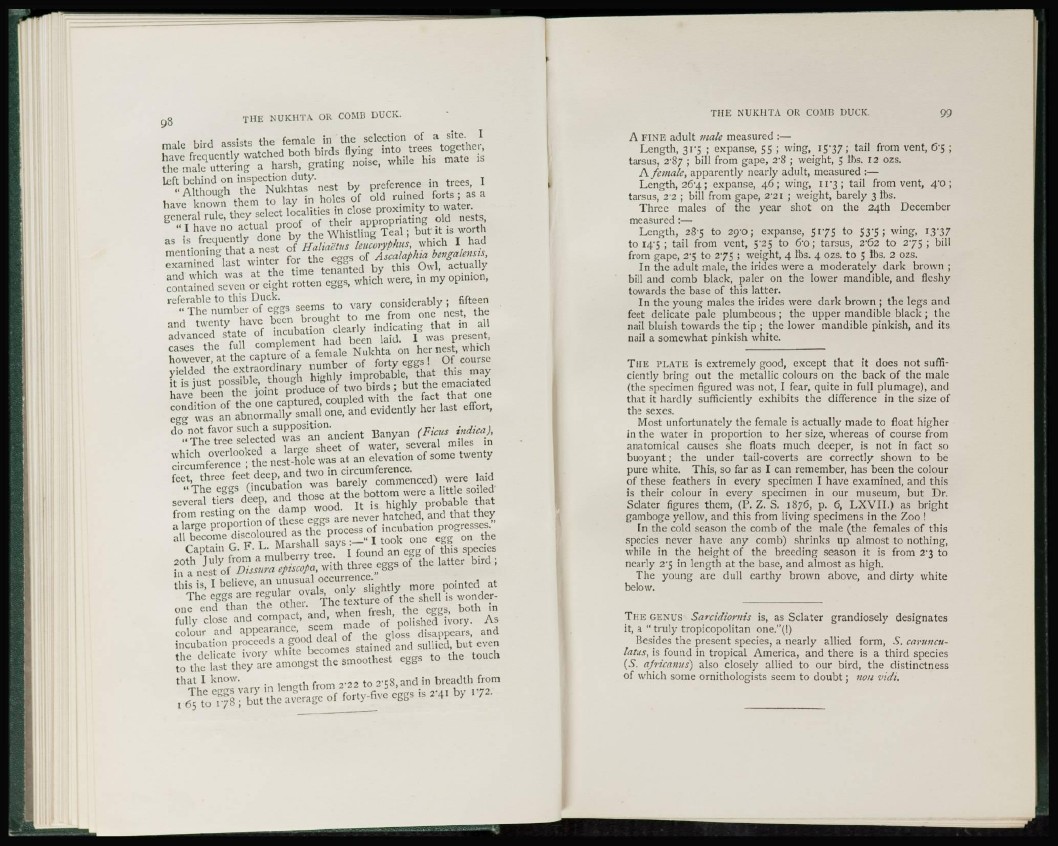
male bird assists the female in the selection of a site. I
have frequently watched both birds flying into trees together,
the male uttering a harsh, grating noise, while his mate is
left behind on inspection duty.
" Although the Nukhtas nest by preference in trees, I
have known them to lay in holes of old ruined forts; as a
general rule, they select localities in close proximity to water.
" I have no actual proof of their appropriating old nests,
as is frequently done by the Whistling Teal; but it is worth
mentioning that a nest of Haliai'tus leucoryphus, which I had
examined last winter for the eggs of Ascalaphia bengalettsis,
and which was at the time tenanted by this Owl, actually
contained seven or eight rotten eggs, which were, in my opinion,
referable to this Duck.
" The number of eggs seems to vary considerably ; fifteen
and twenty have been brought to me from one nest, the
advanced state of incubation clearly indicating that in all
cases the full complement had been laid. I was present,
however, at the capture of a female Nukhta on her nest, which
yielded the extraordinary number of forty eggs ! Of course
it is just possible, though highly improbable, that this may
have been the joint produce of two birds ; but the emaciated
condition of the one captured, coupled with the fact that one
egg was an abnormally small one, and evidently her last effort,
do not favor such a supposition.
" The tree selected was an ancient Banyan ( F i a t s indica),
which overlooked a large sheet of water, several miles in
circumference ; the nest-hole was at an elevation of some twenty
feet, three feet deep, and two in circumference.
"The eggs (incubation was barely commenced) were laid
several tiers deep, and those at the bottom were a little soiled
from resting on the damp wood. It is highly probable that
a large proportion of these eggs are never hatched, and that they
all become discoloured as the process of incubation progresses."
Captain G. F. L. Marshall says :—" I took one egg on the
20th July from a mulberry tree. I found an egg of this species
in a nest of Dissttm episcopa, with three eggs of the latter bird ;
this is, I believe, an unusual occurrence."
The eggs arc regular ovals, only slightly more pointed at
one end than the other. The texture of the shell is wonderfully
close and compact, and, when fresh, the eggs, both in
colour and appearance, seem made of polished ivory. As
incubation proceeds a good deal of the gloss disappears, and
the delicate ivory white becomes stained and sullied, but even
to the last they arc amongst the smoothest eggs to the touch
that I know.
The eggs vary in length from 2'22 to 2,58,and in breadth from
165 to 178 ; but the average of forty-five eggs is 241 by 172.
A FINE adult male measured :—
Length, 31*5 ; expanse, 55 ; wing, 15-37 J t a i ' from vent, &$ ;
tarsus, 2-87 ; bill from gape, 2'8 ; weight, 5 lbs. 12 ozs.
A female, apparently nearly adult, measured :—
Length, 264; expanse, 46; wing, H'3 ; tail from vent, 4'0 ;
tarsus, 22 ; bill from gape, 2'2I ; weight, barely 3 lbs.
Three males of the year shot on the 24th December
measured:—
Length, 285 to 29-0; expanse, 5175 to 53-5 ; wing, 13-37
to 14-5 ; tail from vent, 5-25 to 6'0; tarsus, 2'62 to 275 ; bill
from gape, 2'5 to 275 ; weight, 4 lbs. 4 ozs. to 5 lbs. 2 ozs.
In the adult male, the irides were a moderately dark brown ;
bill and comb black, paler on the lower mandible, and fleshy
towards the base of this latter.
In the young males the irides were dark brown ; the legs and
feet delicate pale plumbeous ; the upper mandible black ; the
nail bluish towards the tip ; the lower mandible pinkish, and its
nail a somewhat pinkish white.
THE PLATE is extremely good, except that it does not sufficiently
bring out the metallic colours on the back of the male
(the specimen figured was not, I fear, quite in full plumage), and
that it hardly sufficiently exhibits the difference in the size of
the sexes.
Most unfortunately the female is actually made to float higher
in the water in proportion to her size, whereas of course from
anatomical causes she floats much deeper, is not in fact so
buoyant; the under tail-coverts are correctly shown to be
pure white. This, so far as I can remember, has been the colour
of these feathers in every specimen I have examined, and this
is their colour in every specimen in our museum, but Dr.
Sclater figures them, (P. Z. S. 1876, p. 6, LXVII.) as bright
gamboge yellow, and this from living specimens in the Zoo !
In the cold season the comb of the male (the females of this
species never have any comb) shrinks up almost to nothing,
while in the height of the breeding season it is from 2-3 to
nearly 2'5 in length at the base, and almost as high.
The young are dull earthy brown above, and dirty white
below.
THE GENUS Sarcidiornis is, as Sclater grandiosely designates
it, a " truly tropicopolitan one."(!)
Besides the present species, a nearly allied form, S, carunculalits,
is found in tropical America, and there is a third species
(S. apricanus) also closely allied to our bird, the distinctness
of which some ornithologists seem to doubt; non vidi.